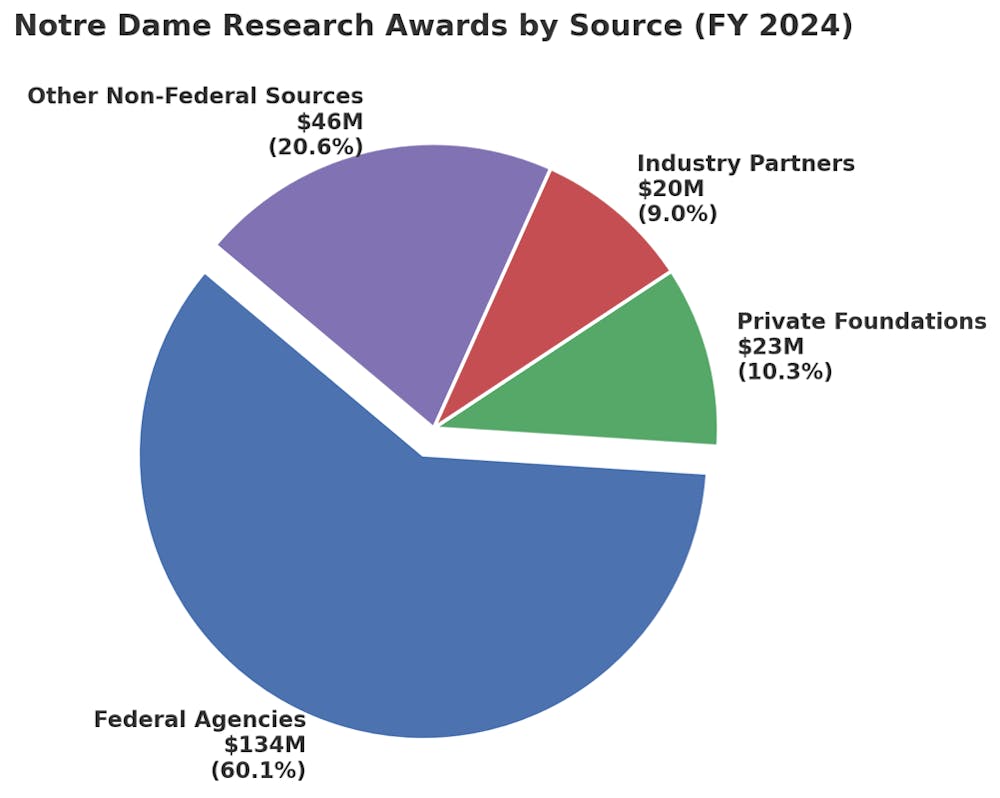The Trump administration has announced a plan that would significantly cut funding to projects awarded grants through the National Institutes of Health (NIH), which funds biomedical research in laboratories across the country. The proposed change would cap facilities and administration costs, also known as indirect costs, at a rate of 15%.
Much of the $35 billion in funding that the NIH awards in grants each year goes to universities and medical schools.
If enacted, the policy could strip over $7 million in federal funds from Notre Dame each year, according to an analysis by The Observer. In fiscal year 2024, Notre Dame was awarded 75 grants through the NIH, totaling $27,727,153.
Federally, the changes would cut spending by an estimated $4 billion.
NIH grants include funding for both direct project costs and indirect costs. Direct project costs include salaries for researchers and project-specific materials costs. Indirect project costs fund expenses such as research building maintenance and operation, equipment shared by multiple laboratories at an institution, administrative, janitorial and compliance staff salaries, data storage and processing, hazardous waste disposal, safety training and utilities.
According to data from the University’s controller, Notre Dame currently has an indirect cost rate of 56.5%, a number which has gradually increased from 48.5% in 2000, the earliest year for which data is available.
Indirect costs are not a percentage of the total project budget but are “added on” to the direct costs of a project. A project with direct costs of $100,000 would receive a maximum of $56,500 in indirect funding under Notre Dame’s current agreement with the federal government. That means indirect costs make up 36.1% of a project’s total funding at Notre Dame.
Slashing the indirect cost rate to 15% would cut indirect cost funding to 13% of total project funding. Under the new changes, a project with direct costs of $100,000 would receive a maximum of $15,000 in indirect funding under the proposal.
22 states have filed a lawsuit against the NIH over the 15% cap. The change has been temporarily blocked by a federal judge’s order.
Elizabeth Archie is a professor at Notre Dame whose research focuses on behavioral ecology and disease ecology. Her lab received $693,032 in NIH funds for its research in 2024. She said she is concerned about the proposed changes.
“Major reductions to NIH would have wide-ranging effects, from local to national and international scales, including hampering Notre Dame’s mission to seek truth and educate, stopping clinical trials, slowing the pace of health-related discoveries, losing jobs and making American universities less competitive,” Archie wrote in an email.
Bradley Smith, an organic chemistry professor at Notre Dame whose lab received $392,917 in funding through the NIH for a project in 2024, also expressed worry over the indirect cost cap.
“Money for indirect costs is absolutely vital for the effective operation of research activities, and without it, there will undoubtedly be a large decrease in the return on investment,” Smith wrote in an email. “To use a simple football analogy, it is foolish to pay professional football players enormous salaries, and not pay for adequate practice facilities.”
Data from the National Science Foundation shows that the share of research funds at universities provided by the federal government has fallen from 67% in 1980 to 55% in 2023 while the share of funds provided by institutions themselves have risen from 14% to 25% in the same time period.
The majority of research at Notre Dame is funded through grants and awards. Notre Dame received $223 million in research awards in 2023, including nearly $120 million from federal agencies. In the same year, the University spent $331 million on research and development.
The share of research covered by grants and awards has at Notre Dame has fluctuated. In 2021, 91% of research at Notre Dame was funded by grants and awards. In 2023, 67% was funded by grants and awards.

Notre Dame's research expenditures have steadily risen from $182 million in 2014 to $332 million in 2023. Research awards have risen from $113 million in 2014 to $223 million in 2023.
Notre Dame’s indirect cost rate is in line with many other similarly ranked institutions. Georgetown University’s rate is 56%, Northwestern University’s rate is 60% and University of Michigan’s rate is 56%. Some universities have notably higher rates, including Harvard (69%) and Yale (67.5%).
Hsueh-Chia Chang, a chemical engineering professor at Notre Dame, received $234,750 in NIH funding for his lab in 2024. In a written statement, he said the ongoing upheaval at NIH causes considerable uncertainty as to how labs at Notre Dame will be able to support current postdoctoral researchers and PhD students. He added research requires “prolonged and well-planned studies” that can “ill-afford” such interruptions.
“It makes it difficult for us to recruit top students/postdocs if we do not know how much funds we have,” Chang wrote.
He also cautioned that international students may choose to study in other countries and that Notre Dame could lose faculty as a result of the cuts.
Notre Dame vice president for research Jeffrey Rhoads, who multiple sources confirmed is working on the response to the proposal, was unavailable for comment.
A written statement provided by the University said, “We are actively monitoring the situation in Washington and working nonstop to document the impacts thus far. We are also coordinating with key partners, such as the Association of American Universities (AAU), the Science Coalition and our partners across Indiana, to underscore the clear value proposition of cutting-edge scientific research, biomedical, global affairs and otherwise. The research that Notre Dame and our partners in higher education do is of critical importance to the nation and the world, and we are working diligently to ensure that it continues uninterrupted.”
Still, the cuts do not pose as great a risk to Notre Dame as they do to some other institutions. Universities with medical schools and those that conduct more medical research are more reliant on NIH funding. Notre Dame ranks 97th in research and development expenditures among US academic institutions, though it has gradually climbed in the rankings over the last several years. Its endowment, by contrast, is the eighth largest among American universities, as of the end of fiscal year 2022.
Editor’s Note: This is the first story in a two-part series about proposed NIH funding cuts. The second story, which will be published later this week, will focus on individual voices and laboratories here at Notre Dame.










